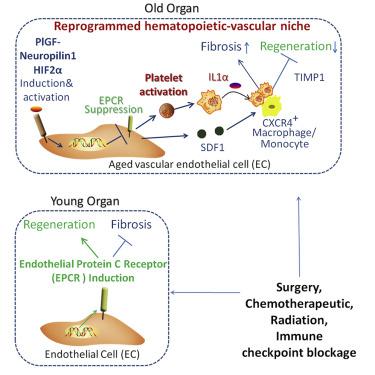Cell Metabolism ( IF 27.7 ) Pub Date : 2020-12-22 , DOI: 10.1016/j.cmet.2020.11.019 Yutian Chen 1 , Qiang Pu 2 , Yongyuan Ma 1 , Hua Zhang 1 , Tinghong Ye 1 , Chengjian Zhao 1 , Xiaojuan Huang 1 , Yafeng Ren 1 , Lina Qiao 1 , Han-Min Liu 1 , Charles T Esmon 3 , Bi-Sen Ding 4 , Zhongwei Cao 1

|
Regenerative capacity is frequently impaired in aged organs. Stress to aged organs often causes scar formation (fibrosis) at the expense of regeneration. It remains to be defined how hematopoietic and vascular cells contribute to aging-induced regeneration to fibrotic transition. Here, we find that aging aberrantly reprograms the crosstalk between hematopoietic and vascular cells to impede the regenerative capacity and enhance fibrosis. In aged lung, liver, and kidney, induction of Neuropilin-1/hypoxia-inducible-factor 2α (HIF2α) suppresses anti-thrombotic and anti-inflammatory endothelial protein C receptor (EPCR) pathway, leading to formation of pro-fibrotic platelet-macrophage rosette. Activated platelets via supplying interleukin 1α synergize with endothelial-produced angiocrine chemokine to recruit fibrogenic TIMP1high macrophages. In mouse models, genetic targeting of endothelial Neuropilin-1-HIF2α, platelet interleukin 1α, or macrophage TIMP1 normalized the pro-fibrotic hematopoietic-vascular niche and restored the regenerative capacity of old organs. Targeting of aberrant endothelial node molecules might help propel “regeneration without scarring” in the repair of multiple organs.
中文翻译:

衰老重新编程造血血管壁龛以阻碍再生并促进纤维化
老化器官的再生能力经常受损。对老化器官的压力通常会以再生为代价导致疤痕形成(纤维化)。造血和血管细胞如何促进衰老诱导的再生向纤维化转变仍有待确定。在这里,我们发现衰老异常地重新编程造血细胞和血管细胞之间的串扰,以阻碍再生能力并增强纤维化。在衰老的肺、肝和肾中,神经纤维蛋白 1/缺氧诱导因子 2α (HIF2α) 的诱导抑制抗血栓形成和抗炎内皮蛋白 C 受体 (EPCR) 通路,导致促纤维化血小板的形成巨噬细胞花环。通过提供白介素 1α 激活的血小板与内皮产生的血管分泌趋化因子协同募集纤维化 TIMP1高巨噬细胞。在小鼠模型中,内皮 Neuropilin-1-HIF2α、血小板白细胞介素 1α 或巨噬细胞 TIMP1 的基因靶向使促纤维化造血血管生态位正常化,并恢复了旧器官的再生能力。靶向异常内皮节点分子可能有助于促进多器官修复中的“无疤痕再生”。











































 京公网安备 11010802027423号
京公网安备 11010802027423号